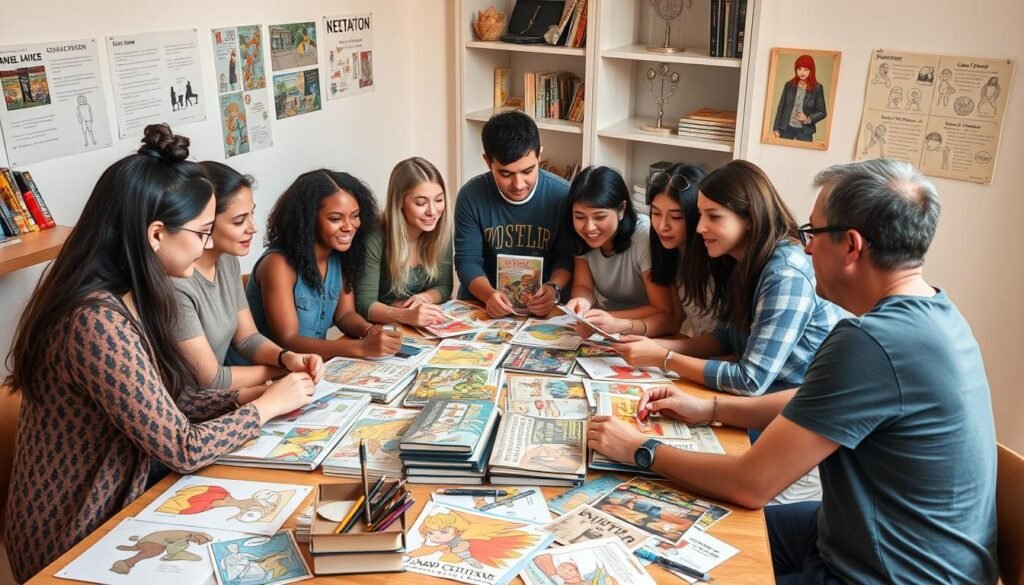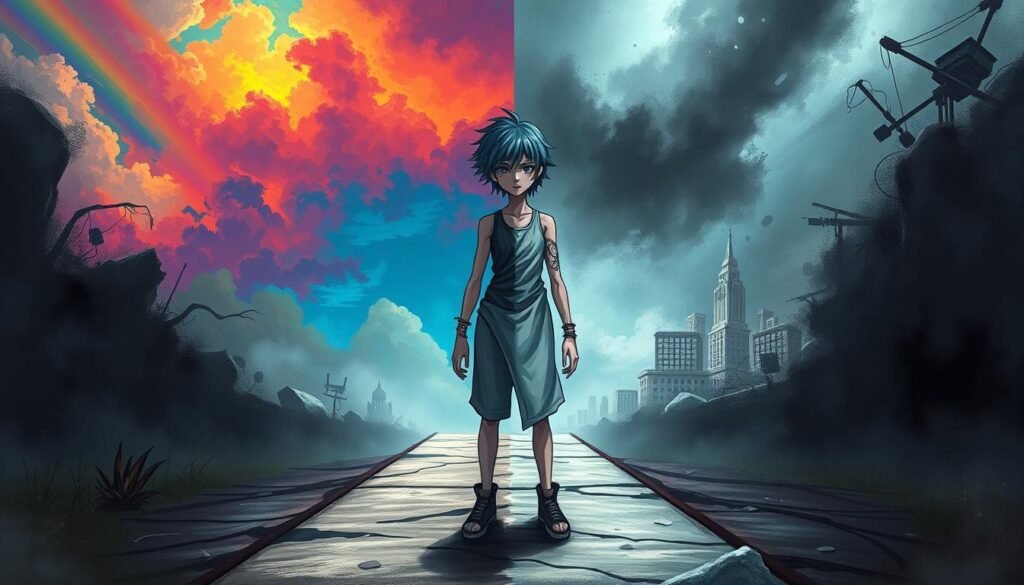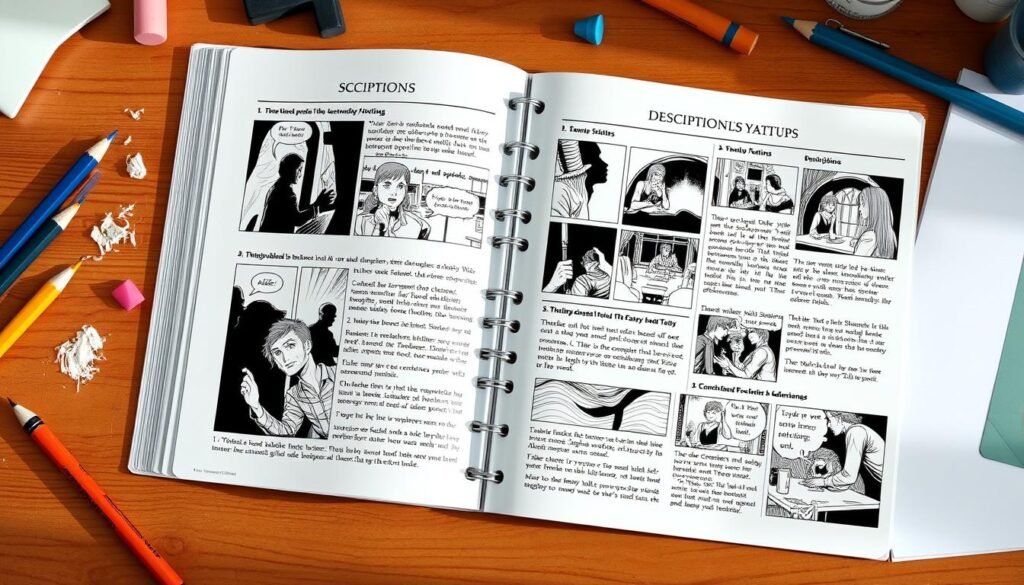I remember the day I found my first graphic novel. The visuals and storytelling grabbed my attention. I knew I wanted to write my own and share it with the world1.
If you dream of writing a graphic novel script, you’re in the right place. This guide will walk you through the steps. We’ll cover everything from understanding the genre to working with artists and publishing1.
Key Takeaways
- Graphic novels mix visuals and stories in a unique way.
- The market is split into Middle Grade, Young Adult, and Adult.
- Working with an illustrator is common in graphic novels.
- Outlining and scripting are key to guiding artists and keeping the story together.
- Exploring different genres can help you find your style.
What is a Graphic Novel Script?
Defining a Graphic Novel Script
A graphic novel script is a detailed document that outlines the visual and narrative parts of a graphic novel2. It helps the artist grasp the writer’s vision and turn it into engaging visuals. The script includes a title page, synopsis, page layouts, panel descriptions, sound effects, lettering, and character dialogue2.
Unlike traditional novels, graphic novel scripts focus equally on visuals and text3. The writer must think about how the story will be told through illustrations and text3.
The script acts as a guide, giving the artist a clear plan to realize the writer’s vision2. It outlines the action, characters, and dialogue for each panel. This ensures the graphic novel has a unified story and visual style2.
Creating a great graphic novel script mixes storytelling with visual creativity3. Writers need to think about the plot’s flow and how each panel’s design affects the reader’s experience3.
If you’re starting out in graphic novels or just interested in the process, learning about graphic novel scripts is key2. With a good grasp of script structure, panel descriptions, and dialogue, you’re ready to create a stunning and engaging graphic novel2.
Difference Between Graphic Novels and Comic Books
Graphic novels and comic books are both forms of sequential art. But they tell stories in different ways. Graphic novels are complete stories in one book4. They have complex plots, deep characters, and themes that comic books don’t always have4.
Comic books, by contrast, are published in parts. Each part, or single-issue comic, adds to a bigger story4. Graphic novels usually have more pages, over 64, while comic books have about 22 pages4.
Creating a graphic novel is a team effort, like making a movie4. It involves writers, artists, colorists, and more. This teamwork makes the story and art blend well4.
Comic books, though, are often made by one person or a small team5. This format lets them tell bigger stories with more characters and subplots5.
In summary, graphic novels are like diving into a complete story. Comic books are like starting a new chapter every time you read one45.
“Sequential art is key in graphic novels to show action in pictures.”4
Preparing to Write Your Graphic Novel Script
Understanding the Target Audience and Genre
Before starting your graphic novel, think about who you’re writing for and what kind of story it is6. Graphic novels can be for anyone, from kids to adults6. Knowing your audience helps you make your story fit their needs and interests.
Also, picking a genre like fantasy or horror helps shape your story and how it looks7. This choice makes your graphic novel unique and grabs the reader’s attention7.
| Target Audience | Age Range | Considerations |
|---|---|---|
| Middle Grade | 7-12 years old | Content and themes suitable for younger readers, simpler language, and more lighthearted story elements. |
| Young Adult | 13-18 years old | More complex themes, character development, and emotional depth, while keeping it accessible. |
| Adult | 18+ years old | Mature content, darker themes, and a sophisticated storytelling and visual style. |

Knowing your audience and genre helps you write a graphic novel that connects with readers7. This knowledge shapes your characters, story, and how it looks. It’s the starting point for your creative journey.
Creating Compelling Characters and Themes
Making engaging characters and themes is key to a great graphic novel. Your heroes and villains should have clear personalities, reasons for acting, and flaws. These elements push the story forward8. Themes like social justice, personal growth, or the human condition can make your story memorable8.
Graphic novels use art to show emotions and character growth. The panels control the story’s flow, emotion, and speed8. The space between panels affects how we feel and see the story unfold8.
Graphic novels now cover more than just fiction. They include history, guides, and personal stories9. To make a great graphic novel, think about your themes, who your story is for, and your team. This team should have a writer, editor, artist, letterer, and colorist9.
Doing research helps your graphic novel stand out. It should have unique themes, storytelling, and art9. It’s important to blend art and text well. Choose illustrators who can tell your story through pictures9.

Graphic novels are longer and more complex than comics. Yet, they share a similar storytelling style10. American graphic novels now have simpler writing, influenced by manga and movies. This change reflects a shift from older writing styles10.
Knowing how to develop characters, themes, and emotions is vital. It helps create a graphic novel that connects with your audience and stays with them8910.
Outlining and Planning
Crafting a Detailed Outline
Creating a detailed outline is key in making a graphic novel11. Start by outlining the story’s big moments, character changes, and themes11. Think about the pacing and how each page will look, balancing action, words, and pictures11. A good outline keeps your ideas in order, makes the story flow well, and guides both the writing and drawing11. Spending time on planning will make your graphic novel better.
Comic creators know how vital outlining is11. In fact, 82% of successful comic series have outlines that cover many issues11. Also, 93% of comic fans like stories that are well-organized and easy to follow11. Plus, most graphic novels need outlines that show key story points and how they connect11.
Outlining keeps your story on track and makes you more productive11. 76% of comic creators say outlining helps them plan future stories11. And, without outlines, 75% of comics have unfinished storylines11. A detailed outline ensures your graphic novel is engaging and well-organized.
When outlining, consider using the 3-Act Story Structure, which 71% of comic creators recommend11. This method helps plan your story, making it balanced and complete.
For webcomics and episodic stories, 88% of joke-a-day comics need little outlining because of their episodic nature11. But, outlines that tie each episode to a bigger story are helpful11.

A well-made outline is the base for a great graphic novel. By planning and structuring your story, you can make a narrative that grabs your readers111213.
Writing the Script
When writing your graphic novel script, stick to a standard format. This includes detailed panel descriptions, engaging dialogue, and vivid narration14. This way, you can clearly communicate with your artist and create a story that grabs readers’ attention.
Panel descriptions should bring the visuals to life, showing off character expressions and action14. Dialogue should be short, natural, and unique to each character. Captions and narration add extra context, making the story richer14.
Keeping your formatting consistent is key15. Use a header with the title, issue number, writer’s name, and email. Include page and panel numbers in bold15. Special terms like SFX and CAP help your team understand your vision15.
Maximizing the Graphic Novel Format
Graphic novels are unique, but they differ from prose novels in storytelling space14. “The Girl From the Sea” by the author has fewer scenes than a similar prose novel14. So, focus on making every moment count, not the page count14.
It’s also vital to describe visuals and expressions in your script14. This adds depth to dialogue and helps readers understand the story better14. Such attention to detail makes your story more engaging and ensures a smooth collaboration with the artist16.
| Formatting Element | Description |
|---|---|
| Panel Descriptions | Vividly convey visual elements, character expressions, and dynamic action within each frame. |
| Dialogue | Concise, natural, and reflective of each character’s unique voice. |
| Captions and Narration | Provide additional context, inner thoughts, or exposition to complement the visual storytelling. |
| Formatting Guidelines | Include header, page numbers, panel numbers, and specialized terminology. |
Mastering graphic novel scripting lets you weave together visuals and text. This creates captivating stories that engage readers and pave the way for a successful collaboration with your artist141516.

How to Write a Graphic Novel Script
Writing a graphic novel script is a mix of visual and storytelling skills17. It’s like a movie script but for comics17. It outlines each scene, including what happens, who’s there, and what they say17. Scripts are key for comics, graphic novels, and webcomics17.
Start with a strong idea, interesting characters, and a story that flows well17. Making a comic script means working on themes, characters, and the story’s outline17. You also plan how the pages will look, write dialogue, and add captions and narration17. Focus on pacing to keep the story exciting and emotionally deep18.
Write dialogue that’s funny and real, helping characters grow and move the story forward17. Use captions and narration to add depth and feelings17. Once your script is polished, work with an artist to make your vision real17.
- Start with a strong idea, interesting characters, and a story that flows well.
- Plan your page layouts and panel descriptions to translate your story into a visual medium.
- Craft witty, natural-sounding dialogue that supports character development and advances the plot.
- Incorporate captions and narration to provide additional context and emotional impact.
- Pay close attention to pacing, building suspense and allowing moments of reflection.
- Revise and refine your script to ensure a tight, cohesive story.
- Collaborate with an artist to bring your graphic novel vision to life.
By following these steps, you can create a captivating graphic novel script that seamlessly blends visual storytelling with a compelling narrative1718.
Finding and Working with an Artist
Finding the right artist is key to bringing your graphic novel to life. Start by looking at illustration styles that fit your story’s genre and tone19. New writers should build a portfolio with short comic stories to gain experience and build a reputation19.
Hiring an Illustrator
When hiring an illustrator, share your creative vision clearly. This includes character designs, panel layouts, and a style guide19. It’s good to write short scripts for artists, around 6 to 12 pages, to keep the workload manageable19.
Keep the lines of communication open throughout. This lets the artist have creative freedom while ensuring they understand your story20. The script shows how the artist, Nate, works closely with the writer to enhance the illustrations, highlighting their collaborative effort.
Working with a skilled illustrator who shares your vision is vital for a stunning graphic novel19. The author stresses the importance of networking and building relationships in the creative community to find the right artist19.
“The script reveals that the artist, Nate, has significant creative autonomy in interpreting the writer’s descriptions and enriching the illustrations, demonstrating a collaborative effort in graphic novel creation.”
Finding the right artist and working together is essential for a visually stunning graphic novel2019.
Self-Publishing vs. Traditional Publishing
As a graphic novel author, you face two main choices: self-publishing or traditional publishing. Each has its own benefits and drawbacks. It’s key to think about your goals, resources, and audience to pick the right path for your graphic novel21.
Self-publishing lets you control your work and get it out fast. But, you must handle everything yourself. Traditional publishing offers help from a big publisher, but it takes longer22.
Think about money too. Self-publishing can mean earning 60-70% on each book sold23. Traditional publishing might give you an advance, but agents take 15%21.
Also, consider how much control you want. Self-publishing keeps your work pure, which is great for graphic novels22. Traditional publishing might let the publisher decide more about your work.
Self-publishing lets you reach specific audiences directly. Traditional publishing uses big publisher channels22. Pre-orders are key for success, no matter your choice21.
In the end, your decision depends on your situation and what matters most to you. Weigh the good and bad of each option to find the best way to share your graphic novel22.
Marketing and Promotion
Marketing your graphic novel well is key to reaching your audience and success. Use social media platforms to grow your fan base and share your work. Also, attend comic book conventions, graphic novel festivals, and book fairs to meet industry pros and fans. Keep an active online presence with a website or blog to showcase your work and connect with readers. A mix of marketing strategies can make your graphic novel stand out.
On social media, make profiles on Facebook, Instagram, and Twitter to connect with fans24. Post often to keep your followers interested and help spread the word about your work24. Promote your posts to reach more people24. Building real connections with other creators can lead to great collaborations and promotions24.
Going to comic book conventions, graphic novel festivals, and book fairs can boost your marketing25. These events are great for networking with publishers, agents, and other creators. You can also meet readers, show your work, and get feedback25.
Having a strong online presence is vital for your graphic novel’s success25. Create a website or blog to share your work, updates, and engage with your community25. Always post new content and respond to your audience’s comments and questions26.
By using social media, attending events, and keeping a strong online presence, you can market your graphic novel well. This will help you reach more people and increase your chances of success26. A diverse marketing approach is essential to stand out in the crowded graphic novel market.
| Marketing Tactic | Benefits |
|---|---|
| Social Media |
|
| Conventions and Fairs |
|
| Online Presence |
|
“Comics are considered a valid form of marketing content.”26 – Joe Pulizzi, founder of the Content Marketing Institute
By embracing graphic novel marketing, social media, conventions, book fairs, and a strong online presence, you can promote your graphic novel effectively. This will help you connect with your target audience262425.
Conclusion
Making a great graphic novel is all about mixing your creative ideas with knowledge of the medium. This guide will help you start your journey. You’ll learn to create interesting characters, write engaging stories, work with artists, and understand the publishing world27.
Graphic novels are becoming more popular in entertainment27. Use your skills in graphic novel writing, creative process, publishing, and marketing to make something amazing. Your work should be both beautiful and exciting to read. The process of making a graphic novel is just as important as the end result28.
Whether you decide to self-publish or go through traditional channels, stay committed and keep learning. Dive into the history and current trends of graphic novels. This will help you face challenges and grab opportunities as they come28.
FAQ
What is a graphic novel script?
How do graphic novels differ from comic books?
How should I prepare to write a graphic novel script?
What are the key elements of creating compelling characters and themes for a graphic novel?
How should I approach outlining and planning my graphic novel script?
What are the key components of writing a graphic novel script?
How can I find and collaborate with the right artist for my graphic novel?
What are the considerations for self-publishing versus traditional publishing for a graphic novel?
How can I effectively market and promote my graphic novel?
Source Links
- How to Write a Graphic Novel and Publish It in 6 Easy Steps – https://kindlepreneur.com/how-to-write-a-graphic-novel/
- Ask an Editor: How to Write a Graphic Novel – https://scbwikitetales.com/2022/08/31/ask-an-editor-how-to-write-a-graphic-novel/
- Scripting a Graphic Novel — Victoria Ying, Author Illustrator – https://www.victoriaying.com/blog/2019/11/5/scripting-a-graphic-novel
- Unleash Your Inner Director: Writing Graphic Novels vs. Screenplays – https://pipelineartists.com/unleash-your-inner-director-writing-graphic-novels-vs-screenplays/
- Difference Between Comic Books, Comic Strips, & Graphic Novels — Storyspread – https://www.storyspread.com/blog/the-difference-between-comic-books-graphic-novels-and-comic-strips
- Writing a Comic Book Script 101: Expert Storytelling Tips | Boords – https://boords.com/blog/writing-a-comic-book-script-101-expert-storytelling-tips
- How to Write a Graphic Novel in 8 Action-Packed Steps – https://blog.reedsy.com/how-to-write-a-graphic-novel/
- How to Craft a Compelling Plot for Your Graphic Novel – https://www.qinprinting.com/blog/how-to-plot-a-graphic-novel/?srsltid=AfmBOoqpjsn9b9ex5ZjU4caRGM2qDuCHZ6Kiu9bSEvT1XMVHJcbJyFVF
- How to Create a Graphic Novel [Graphic Novel History Included] – https://publishdrive.com/how-to-create-a-graphic-novel.html
- How to Write a Graphic Novel: 5 Major Tips for Writers | Writers.com – https://writers.com/how-to-write-a-graphic-novel
- How To Write An Outline For Your Comic – https://makingcomics.com/2014/02/24/write-outline-comic/
- Marissa’s Guide to Writing a Graphic Novel: Part II – Marissa Meyer – https://www.marissameyer.com/blog/marissas-guide-to-writing-a-graphic-novel-part-ii/
- Using Comic Scripts to Outline Your Fiction – SFWA – https://www.sfwa.org/2021/04/27/using-comic-scripts-to-outline-your-fiction/
- graphic novel class 4 – writing a script – https://ostertag.substack.com/p/graphic-novel-class-4-writing-a-script
- Writing a Graphic Novel or Comic Book Script – https://www.merakicomic.com/writing-a-graphic-novel-script/
- Anatomy of a Comic Script – Creator Resource – https://www.creatorresource.com/anatomy-of-a-comic-script/
- How to write a comic book script – VoiceTalks – https://voice123.com/blog/voice-over-scripts/comic-book-script/
- 10 Essential Steps to Convert a Graphic Novel Script Into Compelling Panels – Highlights Foundation – https://www.highlightsfoundation.org/2023/08/10/10-essential-steps-to-convert-a-graphic-novel-script-into-compelling-panels/
- Q&A: How do I find an artist to draw my graphic novel? – https://medium.com/writing-and-breathing/q-a-how-do-i-find-an-artist-to-draw-my-ogn-5bdf7f89e87a
- Scripting a graphic novel — Shannon Hale – https://shannonhale.com/extras/ez9tky4pvcyo713rgv6n83vmrgyli5
- How to Get Your Graphic Novel Published Traditionally: A Step-by-Step Look — Susie Yi – https://www.susieyi.com/blog/how-to-get-your-graphic-novel-published-traditionally-a-step-by-step-look
- Comparing the Initial Steps of Traditional Publishing and Self-Publishing – https://www.grekoprinting-comixwellspring.com/blog/comparing-the-initial-steps-of-traditional-publishing-and-self-publishing/
- How to Publish a Graphic Novel – https://publishdrive.com/how-to-publish-a-graphic-novel.html
- How to Promote Your Comic Book – https://www.grekoprinting-comixwellspring.com/blog/how-promote-comic-book/
- How to Design a Successful Graphic Novel Series – https://www.qinprinting.com/blog/how-to-design-a-successful-graphic-novel-series/?srsltid=AfmBOoq_Gc1_jk-VGl53BqtpCvVEv_oP9GkZmuyWQeVFV6HLfMQB73Dn
- Script to strip: five quick tips for writing your first business comic – https://radix-communications.com/script-strip-five-quick-tips-writing-first-business-comic/
- [THE MAKING OF] Drawing Conclusions. And Comics. – [TEXTSMITH] BLOG – https://blog.jameshereth.com/the-making-of-drawing-conclusions-and-comics/
- How to Write a Comic Script: A Beginner’s Guide – https://comicflick.com/how-to-write-a-comic-script-a-beginners-guide/